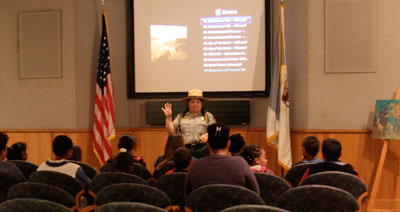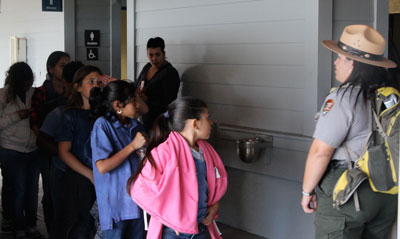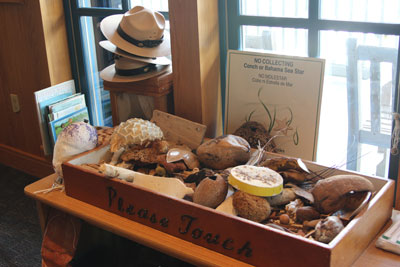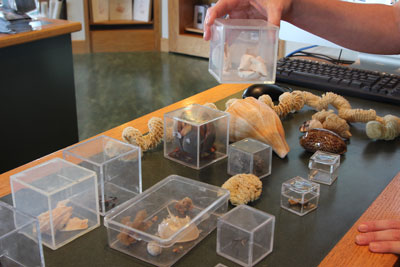
Biscayne Park appeals to kids with activities
HOMESTEAD, Fla.— Oliver Gill walked up to the touch table in the Dante Fascell Visitor Center with wide eyes and a smile larger than life. As a fourth grader looking to play, he no longer was going to use action figures. Live coral, puffer fish and giant hallowed turtles were his new toys for the day.
He was part of a group visiting Biscayne National Park here. The park is just one of the 58 major national parks and other units that make for a great field trip for children.
Located in South Florida, this particular park preserves and protects sensitive areas of Biscayne Bay. The park, which is just 21 miles east of the Everglades National Park, became a national monument in 1968. It was elevated to national park status in 1980 in order to protect a rare species of undersea life.
 |
Ranger Yelitza Sepulveda explains general information about hurricanes to children. The video is about 10 minutes and shows footage of the devastation (Photos by Brittany Weiner).
|
However, Biscayne differs from most national parks in that it is mostly water with little plots of land. This makes it an especially fun park for children such as Oliver to visit as they get to learn and experience the true beauty of marine life.
The park itself is referred to as having the “simple beauty of a child’s drawing,” and this undoubtedly makes it the perfect place for a school field trip.
Vivian Burns, a sixth-grade science teacher at Coconut Palm K-8 Academy, chose the park as the destination for the school’s field trip because of the connection to nature that the park offers. She, along with two other teachers took 58 sixth-grade students to the park.
“It’s real life as opposed to what they learn in the classroom,” said Burns. “They get to see what scientists observe and actually touch and feel things. There’s only so much you can learn from a textbook.
| Yelitza Sepulveda, one of the park rangers for Environmental Education, rounds up the school group after lunch. She is about to lead the children upstairs to the Visitor Center theater to watch the video on the devastation of Hurricane Andrew. |  |
Yelitza Sepulvelda, the park ranger for Environmental Education, leads the tours for school groups that visit the park and also agrees with this view on education.
“We are not interested in making young children pay,” said Sepulveda. “We just want to make sure that they get the ultimate learning experience.”
Sepulveda, among other rangers, works to keep the park’s programs interesting for children. Because learning about all of the different places that the park protects can be overwhelming for children, Sepulveda splits up the park into different stations.
“We run six stations that really give the kids an all-around feel for everything in the park,” said Sepulveda. “We kind of explain it like a puzzle so it’s easier for them to understand.”
The six categories that the park protects are the mangrove shoreline, the bay, the wildlife inventory, the seagrass connection, the northernmost part of the Keys, and the northern part of the third largest coral reef in the world.
 |
The touch table is one of the stations that the children frequent during their tour. The table is located on the second floor of the Dante Fascell Visitor Center and has everything from dried sponges, coral, and puffer fish to hallowed turtles. |
Each place has a “station” where the kids frequent such as the coral station, which is at the bay, and hardwood hammock, which is on the shore. They spend a decent amount of time in each area just enjoying the fresh air, learning, and being out of the classroom.
“My favorite thing I did today was see the pelicans,” said fourth grader Oliver Gill. “We had to write down how many animals we saw in the park and I thought that was really fun.”
In addition to the outdoor activities, school groups also get led around the Dante Fascell Visitor Center, where there are additional learning opportunities. Children frequent the touch table, which is filled with preserved wildlife, the museum and its exhibits, and they watch a short movie on the overview of the park from the devastation of Hurricane Andrew.
“I thought it was extremely appropriate to bring them here,” said Jeanette Martins, another teacher on the field trip. “The kids study these topics in our curriculum this year so it was great for them to get exposure to these resources.”
| Click on the video at right to view an audio slideshow about kids activities at the park narrated by Ranger Yelitza Sepulvelda and prepared by writer Brittany Weiner. |
The touch table is one of the most interesting features for kids, in that they get to feel different preserved animals. There are dried sponges, puffer fish, birds, horseshoe crabs, and even large turtles.
“Sometimes as an activity I will take a couple of broken pieces from the same animal and ask the kids to piece them together,” said Gretchen Messa, a seasonal ranger at the park. “They love it.”
Children tend to prefer scheduled tours, where they get to take part in activities that they normally do not get to do when they go with their families.
“It’s way more interesting going on a tour than going with my family,” said Gill. “I especially liked that we got to watch a movie!”
Messa usually leads the children through the inside part of the tour. There is a mangrove tunnel, which simulates the actual outdoor mangrove, and leads the group into the museum. Children get led around different stations which mirror the outside stations that they visited, but get to learn more facts and see preserved wildlife and fossils.
“We focus on kids coming here and knowing what a national park is,” said Sepulveda. “We want it to be as educational as possible, but also fun.
| Gretchen Messa, one of the seasonal rangers, is holding the Gray Nickerbeak, which is a sea pearl. Some of the dried species are enclosed in plastic casings and displayed on the table next to the touch table because they are more delicate species. |  |
For kids who are extremely enthusiastic about national parks, Biscayne also offers its Junior Ranger Program. The program can be completed at any of the three national parks in South Florida- Big Cypress, Biscayne, or the Everglades.
“The kids who come here to become Junior Rangers are big enthusiasts,” said Messa. “Most kids have been to 30 parks or so.”
In order to become a Junior Ranger and earn a badge, kids must choose from and complete at least three activities in the Junior Ranger book. The book looks similar to a school workbook and is printed on recycled paper with soy and vegetable inks.
Some of the activities include the coral reef search, which is a word-search of words related to the coral reef, and the estuary escape, which is a maze that has different questions about the park. The front of the book also includes a section where kids can mark an “X” on plants and animals that they see and hear while touring.
Lastly, Junior Rangers are awarded a badge.
“It’s a huge ceremony,” said Messa. “They stand under the arrow head, complete the oath, and receive their badge.”
For the even more serious park enthusiasts, kids who complete this program at all three South Florida parks receive a water drop patch, which represents the water at all three parks.
“We just like to see them smile,” said Sepulveda. “And they definitely do when they receive their patch at the end of a long day.”
If You Go
Biscayne National Park is located at 9710 SW 328 St., Homestead, Fla. The visitor center is open from 9 a.m.-5 p.m. everyday.
To organize a school field trip, contact Yelitza Sepulveda at Yelitza_Sepulveda@nps.gov, or 305-230-1100.
The park pays for transportation and requires that either teachers or parents supervise children. School groups also bring their own lunches. The trip is virtually free.
Make sure to check the website as well for different types of tours and exhibits offered at the center.

Comments are Closed